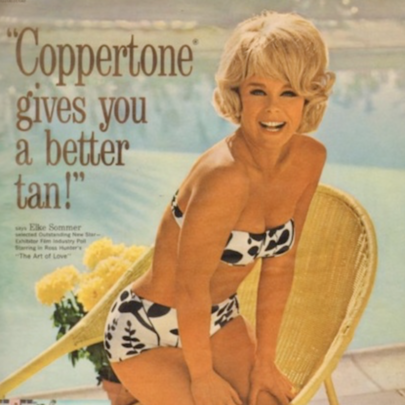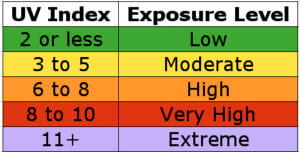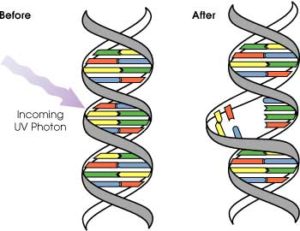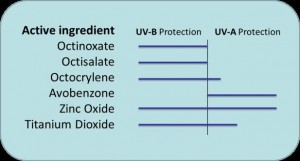 While sunny summer weather usually ushers in better moods with dreams of vacations and more time outdoors, it also brings with it alarming warnings about sun exposure and recommendations about covering yourself with sunscreen from dawn to dusk, even just to go to the mailbox. It makes me wonder if part of the human condition is to try to fault-find everything that we enjoy. Are we as a society using scare-mongering as a way to encourage moderation?
While sunny summer weather usually ushers in better moods with dreams of vacations and more time outdoors, it also brings with it alarming warnings about sun exposure and recommendations about covering yourself with sunscreen from dawn to dusk, even just to go to the mailbox. It makes me wonder if part of the human condition is to try to fault-find everything that we enjoy. Are we as a society using scare-mongering as a way to encourage moderation?
Let me first review the facts about our bodies and sun exposure: We are the products of our genes, and our genes co-evolved on this planet bathed in sunlight. For something seemingly so natural and ubiquitous, can it really be a problem?
 Well, the answer as we would formulate it in the world of statistics is, “it depends.” Long-term or excessive sun exposure does cause DNA damage to the skin. But as Paracelsusobserved, “it’s the dose that makes the poison.” What he meant by this is that everything can be dangerous after some point. There’s even a psychological condition which we see very rarely called ‘psychogenic polydipsia’ in which individuals with the condition are compulsed to over-consume water; so much so that they can become hyponatremic (dilute their essential electrolytes) and affect cardiac function, even leading to death. So armed with that knowledge, let’s reason about how we can safely face the sun.
Well, the answer as we would formulate it in the world of statistics is, “it depends.” Long-term or excessive sun exposure does cause DNA damage to the skin. But as Paracelsusobserved, “it’s the dose that makes the poison.” What he meant by this is that everything can be dangerous after some point. There’s even a psychological condition which we see very rarely called ‘psychogenic polydipsia’ in which individuals with the condition are compulsed to over-consume water; so much so that they can become hyponatremic (dilute their essential electrolytes) and affect cardiac function, even leading to death. So armed with that knowledge, let’s reason about how we can safely face the sun.
While the Earth is constantly bombarded by ultraviolet light from the sun, the intensity of these rays increases during the summer months (largely an effect from the Earth’s axial-tilt). This intensity measurement is roughly captured as the “UV Index,” which is a guide to how much ultraviolet light is likely present for producing sunburn or skin damage. The UV Index takes into account stratospheric ozone concentration, elevation, sunlight angle and levels of different UV present (shorter-wavelength UV is more damaging to skin than longer-wavelength at the same intensity).
While excessive exposure to the sun can lead to premature wrinkling and drying of the skin due to DNA and genetic effects, inadequate exposure also can lead to chronic diseases, depressive  symptoms and vitamin D deficiency, which could be a drawback to excessive sunscreen use. Vitamin D deficiency itself is implicated in a host of problems from cardiovascular conditions and hypertension, to cognitive impairment, to cancer, and even very new research showing a connection with prostate cancer. The Vitamin D Council recommendsgetting as little as 15 minutes of sun exposure daily to stave-off vitamin D-related problems. Once again there is a balance: Too much sun exposure will negatively influence your genes, and too little sun exposure seems to also have negative chronic, systemic effects.
symptoms and vitamin D deficiency, which could be a drawback to excessive sunscreen use. Vitamin D deficiency itself is implicated in a host of problems from cardiovascular conditions and hypertension, to cognitive impairment, to cancer, and even very new research showing a connection with prostate cancer. The Vitamin D Council recommendsgetting as little as 15 minutes of sun exposure daily to stave-off vitamin D-related problems. Once again there is a balance: Too much sun exposure will negatively influence your genes, and too little sun exposure seems to also have negative chronic, systemic effects.
Current Ultraviolet Protection Modalities
Today’s sunscreens tend to fall into a few broad categories: chemical interactive protection and barrier protection. With chemical interactive protection, the sunscreen composition chemicals are such that they interact with impinging ultraviolet radiation from the sun, usually by reducing its energy. This can reduce the penetration of the UV and direct effects within the skin. The barrier protection sunscreens form a thin layer of ultraviolet-opaque material which prevents the passage of most ultraviolet radiation, thus protecting the skin below. While both types are readily available, the safety and efficacy are not equivalent.
Oxybenzone: An additive in chemical sunscreens used because it absorbs UV-B and shortwave UV-A rays. Environmental Working Groupin 2008 identified 588 different sunscreen products which contain oxybenzone.
According to the Centers for Disease Control and Prevention, oxybenzone, one of the primary ingredients in many chemical sunscreens, is found in the bloodstream of 97% of Americans–it is readily absorbed through the skin and is associated with photoallergic reactions (that is, reactions which occur after application and exposure to the sun–which is exactly what their use is designed for). Oxybenzone also appears to bioaccumulate in people (increase in the bloodstream over time with repeated use). This effect is augmented if you also use alpha-hydroxy acids (found in skin lotions as an exfoliant). This is likely due to the fact that that the exfoliants make the skin more permeable, functioning as a penetration enhancer, and the oxybenzone readily absorbs into the skin. Oxybenzone is also implicated in bleaching and deformation of coral reefs. Toxicologist Craig Downs of Clifford, Virginia observed in addition to the coral effects, “Oxybenzone is an endocrine disruptor. It acts like an estrogen and anti-testosterone chemical. It will cause male fish to gain female attributes such as producing egg proteins.”
Homosalate: Also used as a chemical sunscreen and functions by reacting with and blocking UV-B radiation, but not UV-A. Homosalate has limited skin penetration (a good thing), partly owing to its derivation from cyclohexanol. This also gives the compound its greasiness, which makes it not wash off or dissolve in water.
Homosalate has shown low toxicity effects and low potential hormone disruption. It does not have many of the purported negative effects of oxybenzone, but also isn’t a full solar protectant by itself – it only covers a small range of the ultraviolet spectrum in its blocking effect (see chart at bottom), and needs to be coupled with other ingredients to be an effective sunscreen.
Octinoxate: By frequency, the most common sunscreen ingredient, octinoxate is used principally as a UV-B blocking agent because it is less irritating than other sunscreen ingredients.
There is some research indicating that when octinoxate is exposed to UV radiation, it degrades into a less UV-absorbing product. And alsothat octinoxate may make avobenzone less photo-stable. This seems to contradict the reason it is used–to absorb UV rays. The degradation compound produced from the octinoxate may increase levels of free radicals, which can cause genetic changes and damage the skin – and this effect was found to continue after exposure to UV light had ended.
Another study observed that “sunscreens may prevent redness partly by UV absorption and partly by inhibition of the skin’s inflammatory response. As such, sunscreens might promote instead of protect against melanoma.” Many of these tests are done using lab models of skin, however, so their direct applicability to human use is unknown. Because octinoxate has amassed some of the most evidence for hormone disruption, its use is contraindicated by pregnant women and children. Octinoxate also appears to bioaccumulate in the body; This is due largely to octinoxate’s effect as a penetration enhancer and that it easily absorbs into skin. The FDA has noted, as part of the Sunscreen Innovation Act (SIA), “Some sunscreen active ingredients may be absorbed through the skin into the body, making it important to complete studies in humans to determine whether, and to what extent, consumers’ use of sunscreen products as directed may result in unintended, chronic, systemic exposure to these ingredients.”
Zinc Oxide: A white powder used in a suspension in sunscreen lotions and creams, zinc oxide provides the so-called “barrier effect” and physically blocks ultraviolet radiation from the skin. Zinc oxide as a powder can be associated with inhalation hazards in some workplace environments, but in suspension it has a very good safety profile, and is in fact listed as “Designated as safe for general or specific, limited use in food” by the FDA (meaning we actually consume it from time-to-time). There is some evidence that zinc oxide blocks a larger portion of the UV-A spectrum than titanium dioxide, another barrier protectant (below).
Don’t look for sunscreens with zinc oxide “nanoparticles” – there aren’t sufficient data that this formulation of zinc is safe for human use, it may penetrate through the skin.
Titanium Dioxide: Similar in its barrier protection to zinc oxide, titanium dioxide is a bright white powder used in some sunscreens which blocks ultraviolet light.
As with zinc oxide, titanium dioxide in its powdered form can be an environmental hazard in workplaces, and is potentially a carcinogen if inhaled. However, in sunscreen lotions and creams, it is in suspension and does not present this hazard. It is also, like zinc oxide, listed by FDA as, “Designated as safe for general or specific, limited use in food.” As with the recommendation for zinc oxide above, Don’t look for sunscreens with titanium dioxide “nanoparticles”– there aren’t sufficient data that titanium dioxide in this form is safe for repeated human use, it may penetrate through the skin.
Comparing across safety profiles for all relevant sunscreen ingredients, the barrier protection sunscreens (zinc oxide and titanium dioxide) appear very favorable. Stick with formulations whose active ingredients on the back list either or both of these and steer clear of the chemical sunscreens, for which there are far more negative safety data.
Umbrellas, Hats, Etc.
Certainly, we tend to seek cover when the sun just seems too intense, putting on our hats, sunglasses, sitting under cover such as an awning – and these do provide protective benefits. One thing to note is that if you’re seeking the beach and decide to forego the sunscreen because you’re bringing a beach umbrella – you’re likely not as well protected as you might think. A very recent randomized clinical trial of sunscreen use at the beach versus directed umbrella use showed that sunscreen provided better sunburn protection than umbrella use alone. This is likely due in large part to the scattering of UV radiation which occurs on the light-colored sand and surfaces nearby, still allowing considerable exposure to the sun’s rays (though seemingly less, because you’re in the “shadows”). Hats do offer protection that is hard to replicate with sunscreen use: the tips and edges of the ears. These are often neglected when applying sunscreen, and a wide-brimmed hat can do a good job of blocking direct rays on the ears, nose, and cheeks. Remember: a typical baseball hat is only blocking some sun where the brim is (and of course the hat material on the scalp), and many wearers don’t realize that their ears are in the direct path of the sun for hours on end.
SPF Level
Not all sun protection factor (SPF) ratings are accurate; nor are they all rigorously tested. In fact, if you’re looking for strong protection for you and your family, and you pick up a sunscreen product with SPF 50 or higher, there aren’t even good data to suggest that they work more effectively than some with lower SPF figures. The FDA has written, “FDA does not have adequate data demonstrating that products with SPF values higher than 50 provide additional protection compared to products with SPF values of 50.” An SPF of up to 30 should work just fine, so long as it’s not wiped off with clothes or a towel, or washed off with sweat or in the pool or ocean.

How effective is each sunscreen active ingredient across the ultraviolet spectrum? I have drawn up a chart showing where each ingredient protects in the UV-B (left) or UV-A (right) part of the spectrum. As you can see, none of these ingredients is perfect, nor is avoiding sunlight a viable or healthy alternative. The physical barrier sunscreens (zinc oxide, titanium dioxide) tend to perform very broadly across the spectrum, which is a good thing.
The current status of sunscreen ingredients in the US is that there are sunscreen ingredients promoted by different sources which have very different levels of safety and effectiveness. The FDA weighed in with guidance on sunscreens in 2016, stating that there are “new procedures and review time lines for determining whether or not a nonprescription sunscreen active ingredient is GRASE [generally recognized as safe and effective] and not misbranded when used under the conditions specified in a final sunscreen order.” The main stated goal of the guidance is listed thusly: “To protect the public health, it is also important for FDA to balance the potential benefits of these sunscreen products to consumers against their potential risks.” The FDA regulatory processes to vet newer, more-effective sunscreens is tremendously backlogged at the moment. With any luck, there’ll be progress this summer, but every year that goes by we have another 3.5 million cases of skin cancer in 2 million people manifest.
May 11, 2017 | Genetic Literacy Project
